|
Associations with color
are defined, in part by Faber Birren (the author of Color
Psychology and Color Therapy) by our senses, language,
objects (or forms), and personality characteristics. color
conveys moods which attach themselves to human feelings
and our psychic make-up in an almost automatic fashion.
This section presents the results of color associations
and how they compare to other published studies.
Senses
 |
In association with touch,
colors appear warm, cool, dry, and wet (to name a few).
Birren states that this reaction is inherent in the psychological
make-up of most humans and that perhaps it’s build
upon the association of earthly elements such as the
sun,
fire, water, sky, and even deserts (Color
Psychology and Color Therapy, 168). Birren’s
research gained support for the associations with ‘warm’ colors
in 1940 by the Bulletin of the American Physical Society.
S.
M. Newhall, a researcher (and author) performed a study
where he used 50 color samples to solicit responses
from 297 observers
to find out what colors best represented warm and cool.
Newhall stated in his findings that, “the ‘warmest’ judgments
show a minor mode in the violet…but a strikingly
major mode in the red-orange region. The ‘coolest’
judgments exhibit no such marked mode, but range irregularly
all the way from yellow through green and blue to purple.”
(Color
Psychology and Color Therapy, 168) Birren
replied to this study by writing, “In other words,
a color such as red-orange is perceived an unquestionable ‘warm’
by most persons. And greater latitude is shown toward “cool”
hues, for green may express quality to some, blue to
others, and violet to still other.” Later Birren
states that because red will stimulate the autonomic
nervous system,
blue (or colors of similar energy levels) will tend to
relax the nervous system. Thus the reason for a variety
of colors with associations to ‘cool’ correlate
to the number of colors in a specific energy range (Color
Psychology and Color Therapy, 169).
Language
 |
The English language abounds
with expressions pointing to connections between colors
and emotions. It is possible, for instance, to be purple
with rage or green with envy. Sometimes one sees the world
through rose-tinted glasses; at other times one is feeling
blue (Color and Emotions, 1). Bradford J. Hall, the author
of Among Cultures: The Challenge
of Communications, defines
language as, “Language is a rule-governed symbol system
that allows users to generate meaning and in the process,
to define reality.” By this definition alone, we can
see that words that convey color bring meaning to the person
deriving information from that word. The survey asked for
the participants to correlate a specific color to types
of words that don’t inherently assume to be linked
to any specific color. These words include, trust, security,
speed, and high-technology. The word trust is defined by
the American Heritage® Dictionary
of the English Language, Fourth Edition as a Firm reliance on the integrity, ability,
or character of a person or thing. Below is a graphical
representation of the survey results for the word ‘trust.’
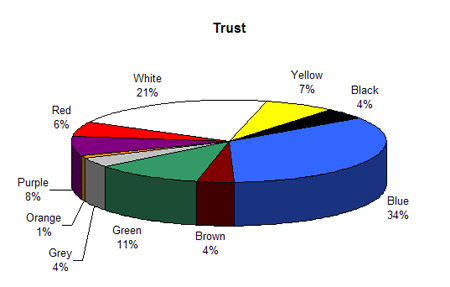
Figure
4.1 - Association with Trust
As you can see, the color
blue gathered the most results from the participants.
Birren correlated
the color blue to the emotional feeling of sadness or
depression (Color
Psychology and Color Therapy, 170). This
came about, Birren continues, because the color blue once
referred to the insane, then expanded to symbolize mental
depression in a general sense. A correlation between sadness
and trust couldn’t be found, therefore, for the purposes
of this study, this represents the first contradiction
between published research and this survey.
The next word ‘security’ shares
close relational ties (in terms of definition) to the previous
word ‘trust.’ The American
Heritage® Dictionary
of the English Language, Fourth Edition defines security
as Freedom from risk or danger; safety. One could say that
without trust, security is hard to establish. Below is
a graphical representation of the survey results for the
word ‘security.’

Figure
4.2 - Association with Security
‘Speed’ is noted
by Birren as a subjective impression for the color red
in his Modern American Color Association
table (Color
Psychology and Color Therapy, 143). Below
is a graphical representation of the survey results for
the word ‘speed.’

Figure
4.3 - Association with Speed
It’s easy to see that
red dominated the results of this question. Red is considered
to carry
the association of intensity, rage, rapacity, and fierceness
(Color
Psychology and Color Therapy, 143). Furthermore,
R. Gerard, the author of Differential
effects of colored lights on psychophysiological functions,
maintained that “the
color red and the emotion of anger both have an energizing
effect that calls for actions and are therefore linked
to each other.” Taking this statement into account,
one could say that the word speed carries the same “call
for action” that anger does (although the type of
action may be different).
Objects
People tend to associate colors
with the quality of objects they purchase. People will
associate colors to objects that represent themselves like
a new car, a home, or even a business suite. In the survey,
several questions were asked with regards to colors and
quality. The first question correlates color to the word(s)
cheap and/or inexpensive. Below is a graphical representation
of the survey results:
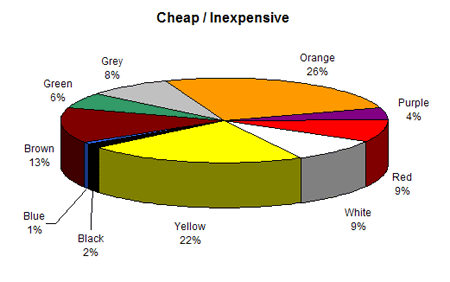
Figure
4.4 - Association with Cheap / Inexpensive
It’s clear that colors like orange,
yellow, and brown are heavily associated with something
cheap and/or inexpensive. What’s interesting about
this pie chart is that it closely correlates to the pie
chart presenting the participants least favorite colors:
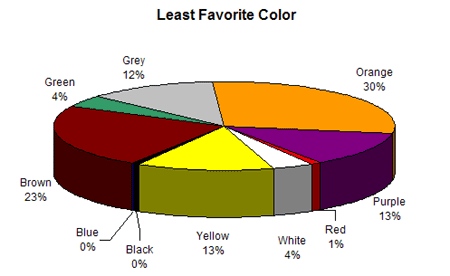
Figure
4.5 - Least Favorite Color
The next phrase is ‘High quality.’ See
below for the graphical representation of the survey results:
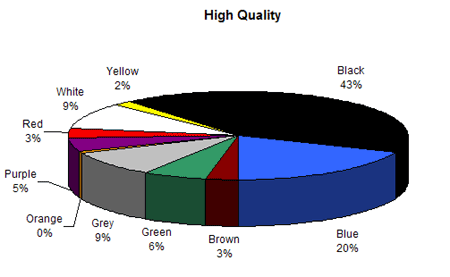
Figure
4.6 - Association with High Quality
As you can see, this is dominated by
black and blue (together totaling 63% of the votes). This
is another example presenting the differences between this
survey and the results of Birren’s study. Birren
states in his Modern American Color Associations table
that Black represents spatial darkness, night, morning,
funeral, depression, negation of spirit and death (Color
Psychology and Color Therapy, 143). Although he may be
correct, there’s no indication that black, to him,
represents anything close to high-quality. There are two
reasons for this: first, I believe he is only writing about
abstract associations. Second, he mentions black with regards
to the ease of seeing the object. He states that colors
like blue, purple, and black cannot be clearly focused
on at distances. Furthermore, the aforementioned colors
(especially black) are very hard to see as the level of
light is lowered.
High technology is the
last phrase examined under the object heading. High technology
is used because it carries (through mass media) characteristics
of high quality. In addition to high quality, high technology
seems synonymous with reliability and dependability. Below
are two pie charts that present the survey results for
high-technology and reliability / dependability.
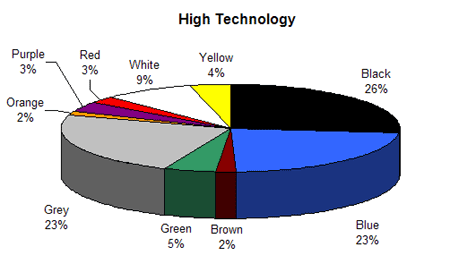
Figure
4.7 - Association with High Technology
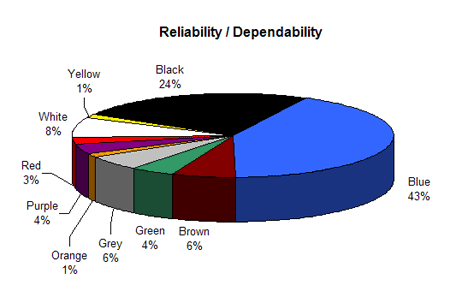
Figure
4.8 - Association with Reliability / Dependability
By looking at the pie charts
for ‘high quality,’ ‘high technology’ and ‘reliability
/ dependability’ one can see similarities. The two
colors that most represent these three characteristics
(according to the data) are black and blue.
Personality
color and personality could be a research
project on its own. That said, I think it’s important
to touch on the survey data and document some clear discoveries,
but not to dive head-first into a area that needs a lot
of attention
to be done well. Three questions were asked in regards
to color and personality: What color would you associate
with
courage / bravery? What color would you associate with
fear / terror? And what color would you associate with
fun?
Courage
/ bravery had an interesting result. See below for the
results of the survey data:

Figure
4.9 - Association with Courage / Bravery
As
you can see the colors blue, red and purple are fairly
even in terms
of percentage of results. Birren notes that purple has
a historically close association with dignity. The phrase
courage / bravery carry a close association with the word
dignity in the United States. Birren’s study associates
blue to the American flag and the armed services. He also
states that red associates with the American flag and the
fourth of July (Color
Psychology and Color Therapy, 143).
The next personality characteristic is
fear and/or terror. See below for the results of the survey
data:
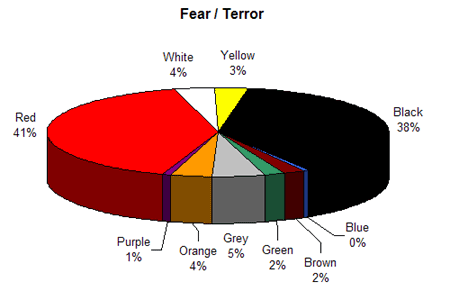
Figure
5.0 - Association with Fear / Terror
The colors red and
black govern this pie chart. Combined they assume 79%
of the vote and are
fairly equal in proportion. Birren associates blood, fire,
danger, rage, and fierceness to red, while at the same
time associating mourning, funereal, ominous, deadly, and
death to black (Color
Psychology and Color Therapy, 143).
It’s understandable that this pie chart contain the
responses it does. One hypothesis for the 40-40 split in
this section may have to do with the wording of the question.
That is, one color may represent the word fear and the
other terror. Since the two words were combined, there
is no way to discover the reasoning without asking the
simplified question.
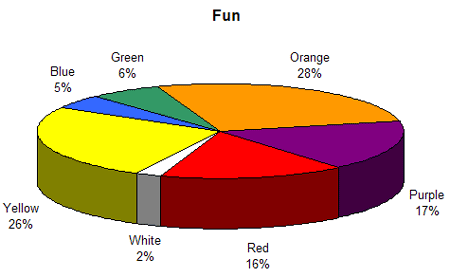
Figure
5.1 - Association with Fun
Associations
like: exciting, mystic, jovial, cheerful, peaceful, melancholy,
youthful correlate to red, purple, orange, yellow, green,
blue, and white respectively in Birren’s study (Color
Psychology and Color Therapy, 143).
In Cailin Boyle’s
book Color Harmony for the Web,
Ms. Boyle states that use of primary colors help to produce
lively and energetic
web sites. The pie chart above contains all the primary
colors and lacks both black and grey. Birren goes into
more detail about this later in his book when he states, “The
order in childhood, therefore, is red, blue, green, violet,
orange, and yellow.” (Color
Psychology and Color Therapy, 176).
Although the results listed in the color survey data set
don’t
completely match the exact order of colors listed by preference,
the colors noted by Birren for children are all present.
|